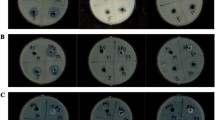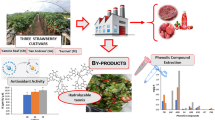Abstract
The effect of Colletotrichum simmondsii infection on the contents of sugars, organic acids, and individual phenolic compounds was investigated in strawberry cultivar ‘Clery’. Primary metabolites were determined with the use of HPLC and secondary metabolites further confirmed with HPLC-MS. Colletotrichum simmondsii caused a decrease in sucrose and an increase in fructose and glucose in strawberry fruit. A significant decrease in the content of malic and citric acids was recorded in infected fruit. 12 forms of ellagic acid, nine flavanols and eight flavonols were identified in strawberry runners and nine forms of ellagic acid, six flavanols, seven flavonols and four anthocyanins in strawberry fruit. Significant differences in individual phenolic compounds in strawberry fruit were detected at the beginning of the infection compared to non-infected fruit. Specifically, ellagic acids significantly increased, flavonols generally decreased, and flavanols and anthocyanins increased with the progression of infection. Similarly, some forms of ellagic acid increased and others decreased in infected runners, procyanidins generally decreased and flavonols, increased but the differences were much less prominent.


Similar content being viewed by others
References
Aaby, K., Ekberg, D., & Skrede, G. (2007). Characterization of phenolic compounds in strawberry (Fragaria x ananassa Duch.) fruits by different HPLC detectors and contribution of individual compounds to total antioxidant capacity. Journal of Agricultural and Food Chemistry, 55, 4395–4406.
Aaby, K., Mazur, S., Nes, A., & Skrede, G. (2012). Phenolic compounds in strawberry (Fragaria x annanassa Duch.) fruits: composition in 27 cultivars and changes during ripening. Food Chemistry, 132, 86–97.
Basson, C. E., Groenewald, H. J., Kossmann, J., Cronje, C., & Bauer, R. (2010). Sugar and acid-related quality attributes and enzyme activities in strawberry fruits: invertase is the main sucrose hydrolysing enzyme. Food Chemistry, 121, 1115–1162.
Bordonaba, J. G., & Terry, L. A. (2008). Biochemical profiling and chemometric analysis of seventeen UK-grown black currant. Journal of Agricultural and Food Chemistry, 56, 7422–7430.
Bracey, D., Holyoak, C. D., & Coote, P. J. (1998). Comparison of the inhibitory effect of sorbic acid and amphotericin B on Saccharomyces cerevisiae: is growth inhibition dependent on reduced intracellular pH. Journal of Applied Microbiology, 85, 1056–1066.
Crespo, P., Bordonaba, J. G., Terry, L. A., & Carlen, C. (2010). Characterisation of major taste and health-related compounds of four strawberry genotypes grown at different Swiss production sites. Food Chemistry, 122, 16–24.
Curry, J. K., Abril, M., Avant, J. B., & Smith, B. J. (2002). Strawberry anthracnose: histopathology of Colletotrichum acutatum and C. fragariae. Mycology, 92, 1055–1063.
Davik, J., Bakken, A. K., Holte, K., & Blomhoff, R. (2006). Effect of genotype and environment on total anti-oxidant capacity and the content of sugars and acids in strawberry (Fragaria x ananassa Duch.). The Journal of Horticultural Science and Biotechnology, 81, 1057–1063.
Guerber, J. C., Liu, B., Correll, J. C., & Johnston, P. R. (2003). Characterization of diversity in Colletotrichum actutatum sensu lato by sequence analysis of two gene introns, mtDNA and intron RFLPs, and mating compatibility. Mycologia, 95, 872–895.
Häkkinen, S. H., Kärenlampi, S. O., Mykkänen, H. M., Heinonen, J. M., & Törrönen, A. R. (2000). Ellagic acids content in berries: influence of domestic processing and storage. European Food Research and Technology, 212, 75–80.
Halbwirth, H., Puhl, I., Haas, U., Jezik, K., Treutter, D., & Stich, K. (2006). Two-phase flavonoid formation in developing strawberry (Fragaria x ananassa) fruit. Journal of Agricultural and Food Chemistry, 54, 1479–1485.
Keutgen, A., & Pawelzik, E. (2007). Modifications of taste-relevant compounds in strawberry fruit under NaCl salinity. Food Chemistry, 105, 1487–1494.
Lindon, C. F., Ramalho, C. J., Pais, I. P., Ramos, A. P., Santos, M. J., Arrabaca, J. D., & Barreiro, M. G. (2012). Fungistatic action of Aureobasidium pulluland on Penicillium expansum in ˝Rocha˝pear: implications for oxidative stress during fruit storage. International Journal of Pest Management, 58, 41–52.
Lobato, A. K. S., Gonçalves-Vidigal, M. C., Vidigal Filho, P. S., Costa, R. C. L., Cruz, F. J. R., Santos, D. G. C., Silva, C. R., Silva, L. I., & Sousa, L. L. (2009). Changes in photosynthetic pigment and carbohydrate content in common bean cultivars infected by Colletotrichum lindemuthianu. Plant, Soil and Environment, 55, 58–61.
Lopez, F. N. A., Quintana, M. C. D., & Fernandez, A. G. (2006). Microbial evolution during storage of seasoned olives prepared with organic acids with potassium sorbate, sodium benzoate, and ozone used as preservatives. Journal of Food Protection, 69, 1354–1364.
Määttä-Riihinen, K. R., Kamal-Eldin, A., & Torronen, A. R. (2004). Identification and quantification of phenolic compounds in berries of Fragaria and Rubus species (Family Rosaceae). Journal of Agricultural and Food Chemistry, 52, 6178–6187.
Marks, S. C., Mullen, W., & Crozier, A. (2007). Flavonois and chlorogenic acid profiles of English cider apples. Journal of the Science of Food and Agriculture, 87, 719–728.
Mayr, U., Michalek, S., Treutter, D., & Feucht, W. (1997). Phenolic compounds of apple and their relationship to scab resistance. Journal of Phytopathology, 145, 69–75.
Michalek, S., Mayr, U., Treutter, D., Lux-Endrich, A., Gutmann, M., Feucht, W., & Geibel, M. (1999). Role of flavan-3-ols in resistance of apple trees to Venturia inaequalis. Acta Horticulturae, 484, 535–539.
Mikulic-Petkovsek, M., Stampar, F., & Veberic, R. (2007). Parameters of inner quality of the apple scab resistant and susceptible apple cultivars (Malus domestica Borkh.). Scientia Horticulturae, 114, 37–44.
Mikulic-Petkovsek, M., Stampar, F., & Veberic, R. (2008). Increased phenolic content in apple leaves infected with the apple scab pathogen. Journal of Plant Pathology, 90, 49–55.
Mikulic-Petkovsek, M., Stampar, F., & Veberic, R. (2009). Accumulation of phenolic compounds in apple in response to infection by the scab pathogen, Venturia inaequalis. Physiological and Molecular Plant Pathology, 74, 60–67.
Milivojevic, J., Maksimovic, V., Nikolic, M., Bogdanovic, J., Maletic, R., & Milatovic, D. (2011). Chemical and antioxidant properties of cultivated and wild Fragaria and Rubus berries. Journal of Food Quality, 34, 1–9.
Perez, A. G., Olias, R., Espada, J., Olias, M. J., & Sanz, C. (1997). Rapid determination of sugars, nonvolatile acids and ascorbis acid in strawberry and other fruits. Journal of Agricultural and Food Chemistry, 45, 3545–3549.
Pineli, L. L. O., Moretti, C. L., Santos, M. S., Campos, A. B., Brasileiro, A. V., Córdova, A. C., & Chiarello, M. D. (2011). Antioxidants and other chemical and physical characteristics of two strawberry cultivars at different ripeness stages. Journal of Food Composition and Analysis, 24, 11–16.
Salmond, C. V., Kroll, R. G., & Booth, I. R. (1984). The effect of food preservatives on pH homeostasis in Escherichia Coli. Journal of General Microbiology, 130, 2845–2850.
Schwalb, P., & Feucht, W. (1999). Changes in the concentration of phenolic substances in the bark during the annual development of the cherry tree (Prunus avium L.). Advances in Horticultural Science, 13, 71–75.
Shivas, R. G., & Tan, J. P. (2009). A taxonomic re-assessment of Colletotrichum acutatum, introducing C. fioriniae comb. et. stat. nov. and C. simmondsii sp. nov. Fungal Diversity, 39, 111–122.
Solar, A., Jakopic, J., Veberic, R., & Stampar, F. (2012). Correlations between Xanthomonas arboricola pv. Juglandis severity and endogenous juglone and phenolic acids in walnut. Journal of Plant Pathology, 94, 229–235.
Sreenivasaprasad, S., & Talhinhas, P. (2005). Genotipic and phenotypic diversity in Colletotrichum acutatum, a cosmopolitan pathogen causing anthracnose on a wide range of hosts. Molecular Plant Pathology, 6, 361–378.
Sturm, K., Koron, D., & Stampar, F. (2003). The composition of fruit of different strawberry varieties depending on maturity stage. Food Chemistry, 83, 417–422.
Strack, D. (1997). Phenolic metabolism. In P. M. Dey & J. B. Harborne (Eds.), Plant biochemistry (pp. 387–416). London: Academic.
Terry, L. A., White, S. F., & Tigwell, L. J. (2005). The application of biosensors to fresh produce and the wider food industry. Journal of Agricultural and Food Chemistry, 53, 1309–1316.
Terry, L. A., Chope, G. A., & Bordonaba, G. (2007). Effect of water deficit irrigation and inoculation with Botrytis cinerea on strawberry (Fragaria x ananassa Duch.) fruit quality. Journal of Agricultural and Food Chemistry, 55, 10812–10819.
Valencia-Chamorro, S. A., Perez-Gabo, M. B., Del Rio, M. A., & Palou, L. (2009). Cultive and preventive activity of hydroxypropyl methylcellulose-lipid edible composite coating containing antifungal food additives to control citrus postharvest green and blue molds. Journal of Agricultural and Food Chemistry, 57, 2770–2777.
Vasco, C., Riihinen, K., Ruales, J., & Kamal-Elden, A. (2009). Phenolic compounds in Rosaceae fruits from Ecuador. Journal of Agricultural and Food Chemistry, 57, 1204–1212.
Vinnere, O., Fatehi, J., Wright, S. A. I., & Gerhardson, B. (2002). The causal agent of anthracnose of Rhododendron in Sweden and Latvia. Mycological Research, 106, 60–69.
Usenik, V., Mikulic-Petkovsek, M., Solar, A., & Stampar, F. (2004). Flavanols of leaves in relation to apple scab resistance. Zeitschrift für Pflanzenkrankheiten und Pflanzenschutz, 111, 137–144.
Acknowledgements
The research is part of program Horticulture No. P4-0013-0481 and the project No J4-4187 funded by the Slovenian Research Agency (ARRS).
Author information
Authors and Affiliations
Corresponding author
Rights and permissions
About this article
Cite this article
Weber, N., Schmitzer, V., Jakopic, J. et al. Influence of Colletotrichum simmondsii R. G. Shives & Y. P. Tan infection on selected primary and secondary metabolites in strawberry (Fragaria x ananassa Duch.) fruit and runners. Eur J Plant Pathol 136, 281–290 (2013). https://doi.org/10.1007/s10658-012-0162-7
Accepted:
Published:
Issue Date:
DOI: https://doi.org/10.1007/s10658-012-0162-7




